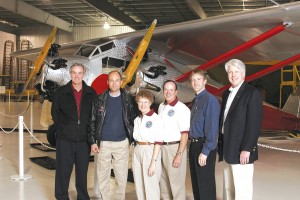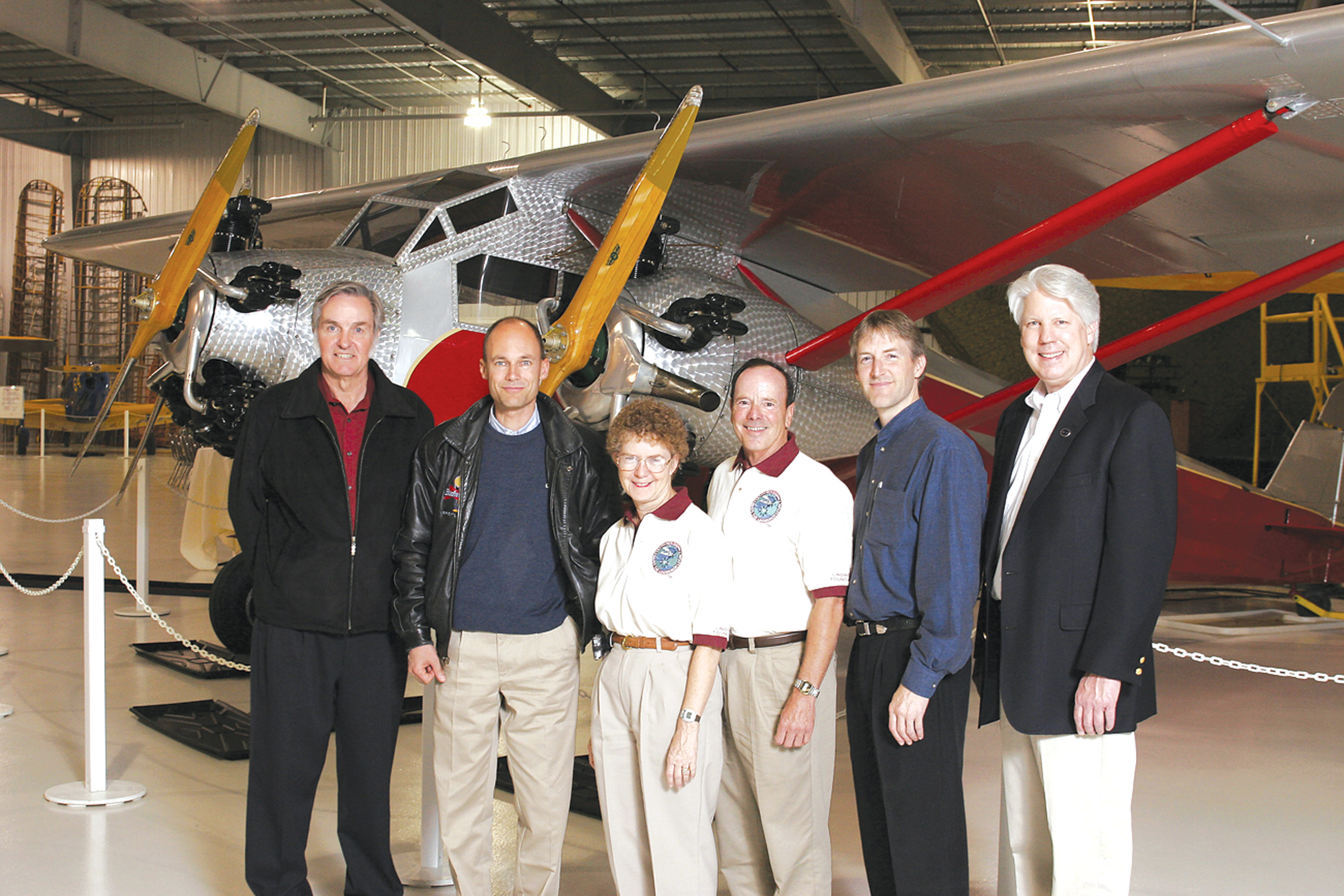
Attendees at “Legends in the Sky” had the chance to visit with L to R: Burt Rutan, Bertrand Piccard, Martha and John King, Erik Lindbergh and Greg Herrick.
Aviation enthusiasts filled the 45,000-square-foot Golden Wings Museum at Anoka County Airport on Friday, May 20, for “Legends of the Sky,” a hangar party hosted by the Anoka, Minn.-based Lindbergh Foundation.
The benefit event was the foundation’s first event in Minnesota in 20 years. It enabled 350 aviation fans and foundation friends to gather to hear stories of history-making aircraft and their pilots, mingle among the vintage airplanes from the Golden Age of Aviation, and to meet several of aviation’s living legends.
Erik Lindbergh, vice chairman of the foundation and grandson of Charles and Anne Morrow Lindbergh, was the host for the evening. Lindbergh re-created his grandfather’s 1927 New York-to-Paris flight in May 2002, in honor of the 75th anniversary of the transatlantic flight that changed the course of aviation forever.
John and Martha King roamed the crowd before taking over their master of ceremonies duties during the program. Their witty and folksy style made aviators and landlubbers alike feel welcome as they told the Lindbergh Foundation’s message of technological and environmental balance.
They explained the pilot’s unique view from the air, which is the basis upon which the Lindbergh Foundation was established. The Kings have revolutionized the flight training industry and have taught nearly half of each year’s class of new private and instrument pilots in the United States. They’re the first couple to both hold every category and class of FAA pilot and instructor certificates. Martha King is the first and only woman to achieve this complete ratings sweep.
Greg Herrick, one of the nation’s preeminent collectors of Golden Age aircraft and a recognized leader in the aviation community, told a hair-raising story about flying his Stinson 6000-B when it encountered serious mechanical problems. Upon making the turn to go back to the airport and land, his windscreen filled up with a large green object, which turned out to be the Fuji blimp! Luckily, some quick maneuvering avoided a crash that “could have rivaled the Hindenburg,” quipped Herrick.
Herrick then read a diary entry written by Anne Morrow Lindbergh, which described her first exciting ride in an airplane with Charles Lindbergh as the pilot. Pointing to his fully restored 1927 Ford Tri-motor, gleaming beautifully on the white painted floor behind the audience, Herrick said, “That same aircraft is with us here tonight behind you, and in so many ways Charles and Anne Lindbergh are with us as well.”
Herrick said, “Aviation, both literally and figuratively, brings people together.”
“For Charles Lindbergh and Anne Morrow on that day it brought them together, and their experience continues through with us here this evening,” he said. “Charles Lindbergh himself observed, ‘I owned the world that hour as I rode over it. Free of the earth, free of the mountains, free of the clouds, but how inseparably I was bound to them.’ His (Lindbergh’s) summary of the gift of flight and the appreciation of this beautiful earth is what this evening is all about.”
Dr. Bertrand Piccard flew from Switzerland to accept the 2005 Lindbergh Award, “for significant achievements toward the balance between our technological advancements and the preservation of our environment,” at a separate event the following evening. An aviation pioneer and balloonist famous for his 1999 round-the-world flight in a balloon, Piccard inspired the audience by talking about his profound metaphor for life. The revelation came during his 1999 balloon flight when he had lots of time to think. He explained that during the trip he realized that life is like flying in a balloon. A person’s life flows with the wind, and if you want to change the direction of your life, you must change altitude. Piccard’s philosophy resonates very much with the Lindbergh Foundation’s message in that he believes society should go with the wind, and with nature, not against it.
Dr. Clayton Cowl, chief of the aviation and aerospace medical section at the Mayo Clinic, is a commercially rated balloon pilot and is considered a national expert on hot air balloon safety. He told of the extraordinary contributions Charles A. Lindbergh brought to aviation through the high-altitude testing he participated in at the Mayo Clinic in Rochester, Minn., in 1942. Lindbergh spent two weeks at the Mayo Clinic conducting a series of experiments to test the effects of high altitudes on the body.
“I think the people who did the type of shirt-sleeve research conducted by Charles Lindbergh were incredibly brave,” said Dr. Cowl.
Dr. Paul MacCready Jr. was also present, although not a speaker at the event. A Lindbergh Foundation director and founder and chairman of AeroVironment, Inc., MacCready has been pioneering the use of alternate energy sources in aviation for over 50 years, developing vehicles and devices that strike a balance between nature and technology. He became known as the “father of human-powered flight” when his Gossamer Condor made the first sustained, controlled flight by a heavier-than-air craft powered solely by its pilot’s muscles. His Gossamer Albatross was the first aircraft to fly across the English Channel using only human power, in 1979. MacCready also won the Kremer Prize for both his Gossamer Condor and Gossamer Albatross.
Burt Rutan capped off the evening by outlining his historic mentors and the progress of aviation and space travel during the course of his lifetime. He concluded his talk by showing the takeoff and landing of SpaceShipOne on Oct. 4, 2004, and narrating for the audience specific details about the flight.
The Lindbergh Foundation ([http://www.lindberghfoundation.org]) is a public 501(c)(3) nonprofit organization, which strives to improve the long-term quality of all life by balancing technological advancements and the preservation of our environment. The foundation also values individual initiative and accomplishments. Its programs are devoted to supporting, honoring, and educating individuals, through three major programs: the annual honorary Lindbergh Award, presented to individuals for significant contributions toward balance in their work; the Lindbergh Grants program, which provides grants in amounts up to $10,580 (the cost of building the “Spirit of St. Louis” in 1927) for research or education projects that will make important contributions to the technology/environment balance; and a variety of educational events and publications centered on the balance theme.











